COP26: 'Broads of the future would be familiar to Romans'
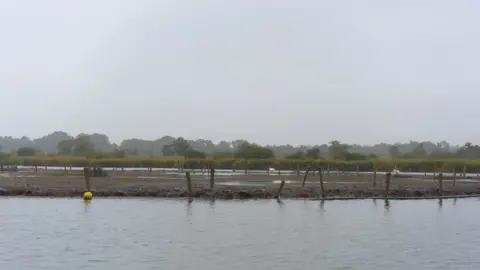 BBC
BBCOf all the UK's National Parks, the low-lying interconnected mosaic of wetlands known as The Broads is the most vulnerable to rising sea levels. What will The Broads, which stretch across Norfolk and Suffolk, look like in 100 years' time? And what can be done to try to safeguard this internationally important area, its wildlife and the people who live and work here?
There's an excavator strapped to a pontoon in the middle of Hickling Broad.
It is being used to dredge sediment to build a new reedbed habitat.
This restored reedbed is known as Chara Bay, and it was made using geotextile tubes and that dredged sediment.
Eventually, reed rhizomes will be placed on to the top of the lagoon edge, which will thicken out and spread into the interior.
The final reedbed will, it is hoped, become both a haven for wildlife and will lock in carbon as peat slowly accumulates there.
The project at Hickling, which is owned and managed by Norfolk Wildlife Trust, is one of the various projects in the area aimed at locking carbon away.
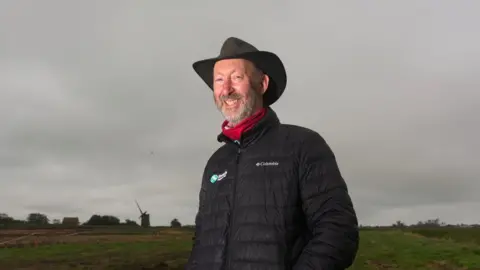 BBC
BBCPeat lies at the heart both of the Broads' past and its future.
The Broads itself is the result of medieval peat digging. Once taken away, efforts are now under way to replenish it.
"The Broads has always changed," says John Packman, chief executive of The Broads Authority. "It is not a natural landscape, it is the result of mankind.
"I still see in 100 years' time the broads still being a very special place, but it will be rather different.
"The biggest threat to The Broads is sea level rise."
Close to the sea, The Broads is a flattish landscape and low-lying.
"The sea has been a threat in the past. We had big floods in 1938 and 1953," says Mr Packman.
"The sea can either come up the rivers through these big events that happen in the North Sea or through the coast.
"That, long term, must be the big threat for us.
"The sea is going to rise by between half a metre (19in) and a metre (39in) over the next 100 years so my grandchildren will be facing a very different environment."
A one-metre rise in the sea level would put much of The Broads under water.
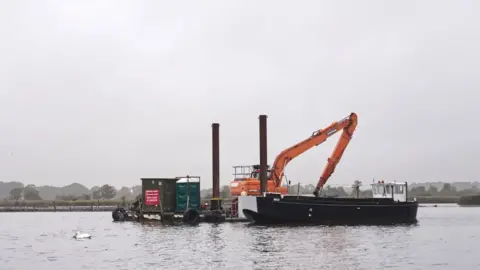 BBC
BBCThis could happen in a sudden catastrophic event, he says.
"And nature struggles with catastrophic events," he says. "That is why we are particularly trying to engage with local people to see if there is a way over the next 50 years of finding ways in which this landscape can adapt to the threats that it faces."
So what might The Broads of the future look like?
"We will probably have saltmarsh, or more saltmarsh, and different forms of agriculture and that is one of the things we are exploring," he says. "I still see it as being an important place for tourism and a critically important place for wildlife.
"Most of the settlements were built on little bumps," he says. "So I suspect those settlements are going to be there for a long, long time, but they will be surrounded by a different landscape.
"If you look at the maps of when the Romans were here, it was a very different landscape. We may see something that may be more familiar to the Romans than it is to us."
But what can be done to manage the impact of climate change in a place like this?
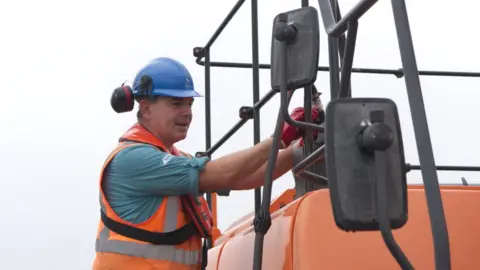 BBC
BBCMr Packman says the authority's role lies in "demonstrating what other people might do".
"For instance, using different forms of fuel that burn much more cleanly," he says.
"Using electric vehicles and thinking about how we operate and how our staff operate, such as more working from home, cutting down all of our emissions, but also, critically, working with the public.
"Perhaps we can have a bigger effect by working with the people in this part of the world.
"In the same way restoring rainforest locks in carbon, we are doing that on a smaller scale in The Broads," he says. "So reed grows very rapidly and it locks up carbon and lays down peat - and the peat that our ancestors dug up releases carbon when it is burnt.
"If we can lay down peat now then we are soaking up some of the carbon which will mitigate the impact for the future."
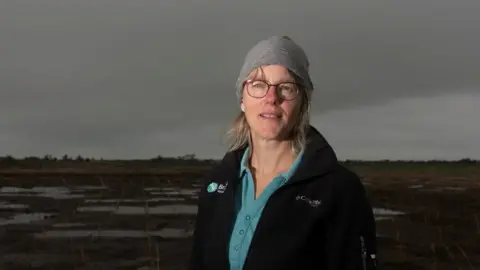 BBC
BBCAbout six miles (9.6km) from Hickling lies a patch of land in the village of Horsey.
The Broads Authority is using it to show what might profitably be grown in the area in the future.
"We are planting it with two types of plants," says Andrea Kelly, the authority's environment policy advisor.
The plants being grown are reed and typha (or reedmace).
"These plants are crops," she says, "and can be grown for harvest.
"It is a viable wet farm system."
Such plants can be grown for thatching or as an insulation material in buildings.
"This is something of the future," she says. "We want conversations with farmers and land managers about the viability of such a crop.
"Reed is imported from the Ukraine and China - why can't we grow that here?"
Such crops, she says, take encroaching water, clean it while also locking carbon into the ground beneath.
But will such crops appeal to farmers?
Possibly, but only if they make business sense, says Rob Wise, the National Farmers' Union East Anglia Environment Adviser.
"Farming of wet crops may have a niche role to play in The Broads if the economics can be made to stack up," says Mr Wise.
"Where wetland already exists, this will be easier and the availability of carbon credit payments could make this viable.
"Where land use change is required, from grassland or arable, this will only ever be viable with long term payments for the land use change."
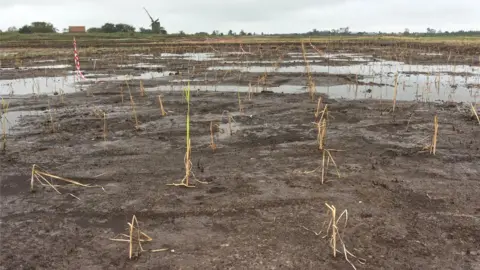 BBC
BBCThe Broads Authority is at the centre of a new partnership group called Electrifying The Broads.
The "cruiser" fleet of private and hire boats, the authority says, is almost entirely fossil-fuel powered, and there are currently no environmentally friendly options for hire vessels that spend weeks away from their base.
The group, which will be funded by the Department for Transport alongside 54 other schemes across the UK, will look at ways of decarbonising the propulsion of the most polluting cruising vessels and look at the need for electric charging infrastructure throughout The Broads.
Once that work is carried out, the scheme will seek to show how technologies such as biofuels and hydrogen fuel cells might be used by The Broads' river users.
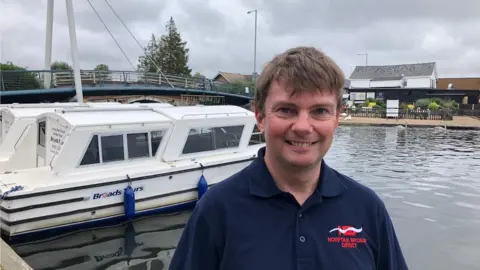 Shaun Whitmore/BBC
Shaun Whitmore/BBCTourism is amongst The Broads' biggest industries.
The boat hire industry is changing too.
Although Broads Tours has had two electric boats for about 20 years, James Knight, a director, says the firm plans to acquire 40 new electrically propelled day boats for their fleet.
"We've always been quite interested in how we can start to decarbonise our fleet," he says. "It is what the customers are asking for and it means less maintenance and less servicing, so it means much less hassle for us.
"We are very excited about it."
Photography by Laurence Cawley unless otherwise stated

Find BBC News: East of England on Facebook, Instagram and Twitter. If you have a story suggestion email eastofenglandnews@bbc.co.uk
